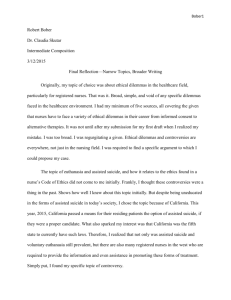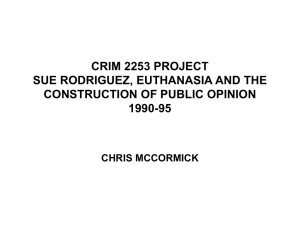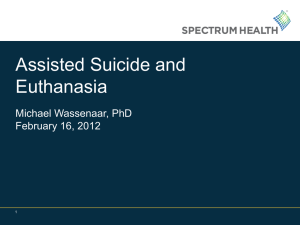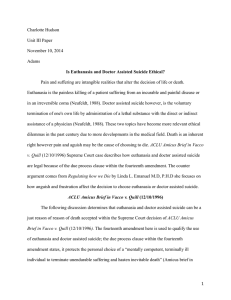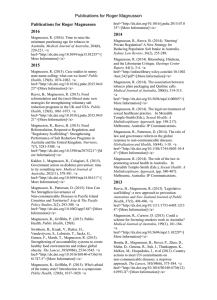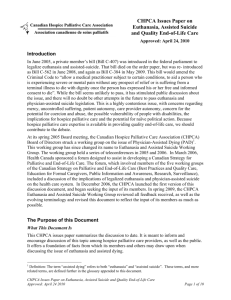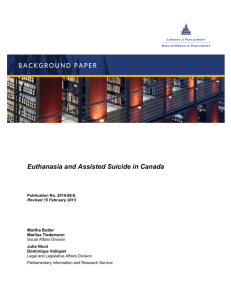1754 - foreword - angels of death
advertisement
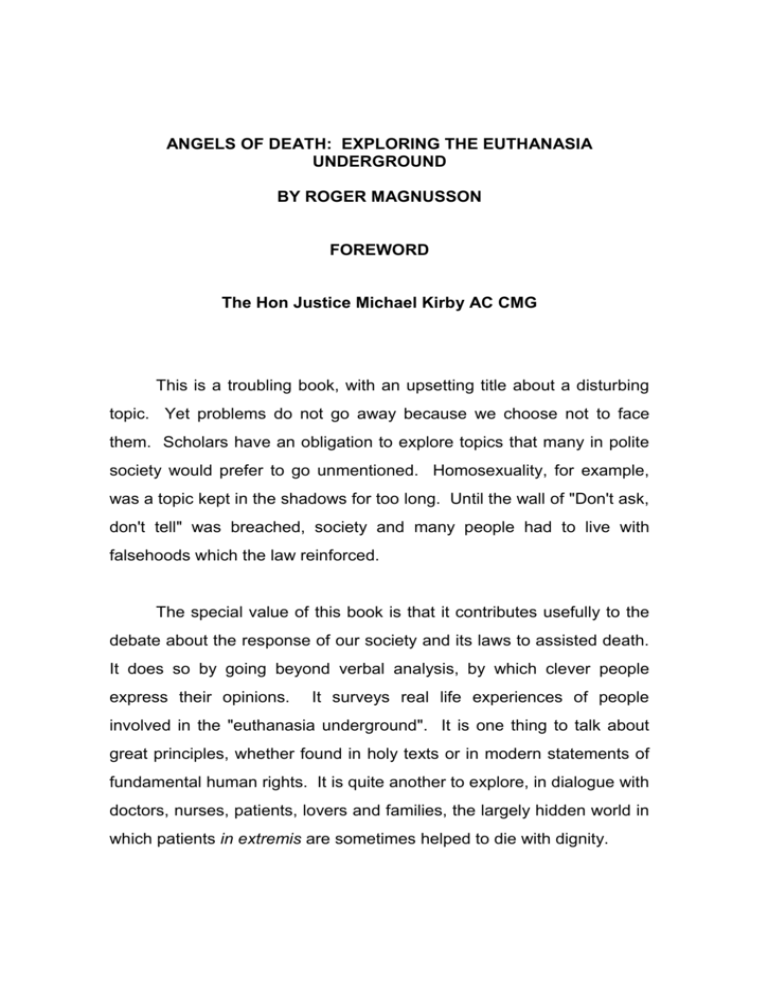
ANGELS OF DEATH: EXPLORING THE EUTHANASIA UNDERGROUND BY ROGER MAGNUSSON FOREWORD The Hon Justice Michael Kirby AC CMG This is a troubling book, with an upsetting title about a disturbing topic. Yet problems do not go away because we choose not to face them. Scholars have an obligation to explore topics that many in polite society would prefer to go unmentioned. Homosexuality, for example, was a topic kept in the shadows for too long. Until the wall of "Don't ask, don't tell" was breached, society and many people had to live with falsehoods which the law reinforced. The special value of this book is that it contributes usefully to the debate about the response of our society and its laws to assisted death. It does so by going beyond verbal analysis, by which clever people express their opinions. It surveys real life experiences of people involved in the "euthanasia underground". It is one thing to talk about great principles, whether found in holy texts or in modern statements of fundamental human rights. It is quite another to explore, in dialogue with doctors, nurses, patients, lovers and families, the largely hidden world in which patients in extremis are sometimes helped to die with dignity. 2. It is natural that the law should be concerned about the death of human beings. Death is the antithesis to life, which is the precondition to consciousness, essential to the enjoyment of liberty and the pursuit of happiness. Even the most primitive legal systems provide rules, supported by sanctions, against terminating human life. Many societies still punish attempted suicide. Although this is no longer an offence in Australia, assisting or encouraging another to attempt to commit suicide is an offence in five jurisdictions. Yet if the information contained in this book is, even in part, a true reflection of what is happening, we are facing another instance where the law is apparently being honoured in the breach as much as in the observance. Some will draw the inference that the answer to this disclosure is a more vigorous enforcement of the law against anyone who assists, or attempts to assist, to end the life of a patient, even one with an incurable condition who wants to die. Others will read this book and infer that the present lack of "quality control" demands that we face reality, introduce strict legal protections, impose proper procedures and expel amateurs and "cowboys" from the assisted suicide business. Still others will find the whole topic so complex, puzzling and painful that they will prefer to ignore it. But the point that Dr Magnusson makes is that to ignore the issue is, effectively, to accept the realities that were long suspected, but which this book now documents. 3. In a sense, it was the advent of HIV/AIDS that demanded a book of this kind. Hospital practices in relation to terminating life support, hospice practices of inducing coma and death by palliative injections and terminal decisions by mostly elderly patients could earlier usually pass unnoticed. But it was the arrival of AIDS, with its profound impact on a large cohort of young people (mostly homosexual men) that presented the new dimension to the euthanasia debate that is a chief focus of this book. These were people, often already alienated from the law, their families and society, who wanted to take control of their last moments of life. There are powerful passages in this book that illustrate the awful circumstances of the close of life of many such people, rejected by their genetic family but loved for whom they are by others, determined to support them on their last journey. There is a tragic irony in the fact that some of those who oppose assisted death most vehemently are amongst the most intolerant of the rights of such patients to live with dignity according to their nature. HIV/AIDS has thus presented a new dimension to the euthanasia debate. If for no other reason, this book is to be welcomed because it explores that issue. The most valuable aspect of Dr Magnusson's analysis is that he avoids dogmatic adherence to the camp of absolute opposition to, or of uncompromising support for, legislation to permit and regulate the rights of terminally ill patients who choose to die. He does not disguise the powerful points made by each side of the debate. He does not pretend that the issue can be simply handed over to opinion polls which regularly show a majority of respondents in favour of a facilitating law of some 4. kind. He does not disguise his anxiety about instances of "botched" "mercy killings". He acknowledges the importance of the symbolism of the law and of health care ethics that remain committed to the defence of human life. To some extent, modern medication and palliative care, as described in the book, bypass the need, for many people, of physicianassisted suicide. The "break through dose" of morphine, administered to ease intolerable pain, will hasten death as those who administer it well know. Yet the debate addressed in these pages will not go away. Relief of pain is not the only consideration. Many readers will agree with the opinion of Justice Brennan of the Supreme Court of the United States in the Cruzan Case, quoted in the closing chapter: "Dying is personal. And it is profound. For many the thought of an ignoble end, steeped in decay, is abhorrent". People of this persuasion will see the effective power to control the end of one's life as the ultimate expression of personal autonomy, inherent in human dignity. Opponents will view it as defiance of God's will or as a bad signal that enhances the power of doctors and families over vulnerable patients. All of the main arguments are laid before the reader. Whilst Dr Magnusson offers his own opinion, he acknowledges that it is "tinged with some uncertainty". I suspect that that will be the conclusion of many who reflect, without dogma, upon the puzzles and dilemmas uncovered here. 5. What is to be done? Like Dr Magnusson, I will leave the privilege of finding the correct conclusion to the reader. But after this book, the debate will never be quite the same. Michael Kirby High Court of Australia, Canberra 1 October 2001 Words: 1060 ANGELS OF DEATH: EXPLORING THE EUTHANASIA UNDERGROUND BY ROGER MAGNUSSON FOREWORD The Hon Justice Michael Kirby AC CMG

